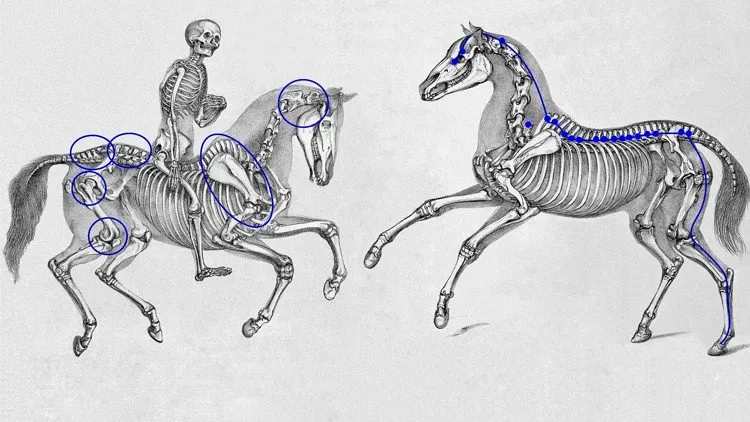Equine Partnered Bodywork - Introduction
What / where is the point?

Equine Partnered Bodywork - Introduction udemy course
What / where is the point?
What you'll learn:
- Explore multiple methods, tips and techniques on how to identify, find and release tension in a horse
- See a demonstration of an evaluation process to determine discomfort areas in the horse
- How to greet a horse and determine if a horse is receptive to you
- Introduction to Traditional Chinese Method way of thinking.
- Observe a demonstration working with several horses using the Invite / mutual greeting technique
- Observe activating the Bladder Meridian with several horses who then self correct by releasing tension
- Identify with horse behavior that is beyond this course, but will be covered in the advanced course
- Connect with horses on a deeper lever by observing and respecting their boundaries
- Apply and practice the techniques observed with your horse or experience a virtual session!
- Communicate more effectively in a mindful way with horses
- Learn where the Bladder Meridian is on a horse and why this work is so quiet yet powerful.
Requirements:
- You will want to be curious and mindful with horses, willing to listen and explore
- Previous equine knowledge helpful, but not necessary for this Intro course
- It will be helpful to have at least one horse to work with, but I set up a quiet virtual session where you can experience the work
Description:
Equine Partnered Bodywork will introduce a light touch technique we can do WITH our horse. Through practicing our state of mindfulness and presence, we discover the connection of how to ask for and observe our horse's consent to partner. By applying a light touch to the neck of a horse, we will see and recognize different levels of response. As a result, we discover by applying a light touch and staying on the point or area, the horse will ‘process and release’ their own tension, be it physical, mental, emotional. We in turn will feel our stress level melt away into relaxation.
Thousands of hours spent with horses has confirmed this overly simplified concept - Give a voice to discomfort, allow it to show up and be released. When we see and hear the disturbance, truly listen and stay with the horse until they release the disruptive energy, their body will then self correct. I have observed and filmed horses doing this with and for each other. An amazing example is a young and very large Percheron client has hind end weakness due to nerve damage. I began to realign his ribs, his pasture mate stepped forward and looked me straight in the eye then proceeded to work on each rib, starting just behind the shoulder and worked his way back. He worked on 6 ribs individually - slight nip and pull of the skin then his nose nuzzled across the bone top to bottom and he moved to the next rib... He then looked me straight in the eye and stepped back, he was beaming with his brilliance.
By fully connecting with the horse's heart and spirit, offering support, 'holding space', the disturbance is able to simply melt away. It is important to check in often so problems don't become acute or chronic. Future courses will dig in deeper to issues that don't fully self correct, but this is the place to start. We must get ourselves in a mindful state of presence, without an agenda, to listen with an open heart for energetic imbalances. This activity is not meant to be done with an 'intention to fix'. Nor will you want to start working with a horse that has issues or injuries that would be better addressed by a Veterinarian.
Personal responsibility of the student who chooses to engage in activities presented in this course:
PARTICIPANTS WHO ENGAGE IN EQUINE ACTIVITIES ASSUME THE RISKS OF ENGAGING IN AND LEGAL RESPONSIBILITY FOR INJURY, LOSS, OR DAMAGE TO PERSON OR PROPERTY RESULTING FROM THE INHERENT RISKS OF EQUINE ACTIVITIES
The skeletal image used in videos - left, right and top view are screenshots from 3D Horse Anatomy software from Biosphera3D.
The design of added circles and acupoints (© Nancy Horne) show major areas used in EPB bodywork. The software programs used in this course creation are the Adobe apps - Photoshop, Illustrator, Premier Pro, Apple - Keynote and ScreenFlow.
Who this course is for:
- People who want to develop a better connection with their horses
- Horse Trainers, Bodyworkers, Caregiver, Owner, Rescue and Shelter Supporters
- Empaths, Sensitives, Introverts, Intuitive's, Highly Sensing Persons, Mindful and Conscious focused
- Horse Enthusiasts
- People who are seeking to explore mindfulness to find peace within their heart and mind
- Six Sigma Green Belt Training and Certification
- CCNA Security Real World Labs - Cisco ASA, Network Security
- CCNP Route 642-902 Implementing Cisco IP Routing
- IP Addressing and Subnetting
Course Details:
-
2 hours on-demand video
-
3 downloadable resources
-
Full lifetime access
-
Access on mobile and TV
-
Assignments
-
Certificate of completion
Equine Partnered Bodywork - Introduction udemy free download
What / where is the point?
Demo Link: https://www.udemy.com/course/equine-partnered-bodywork-introduction/
